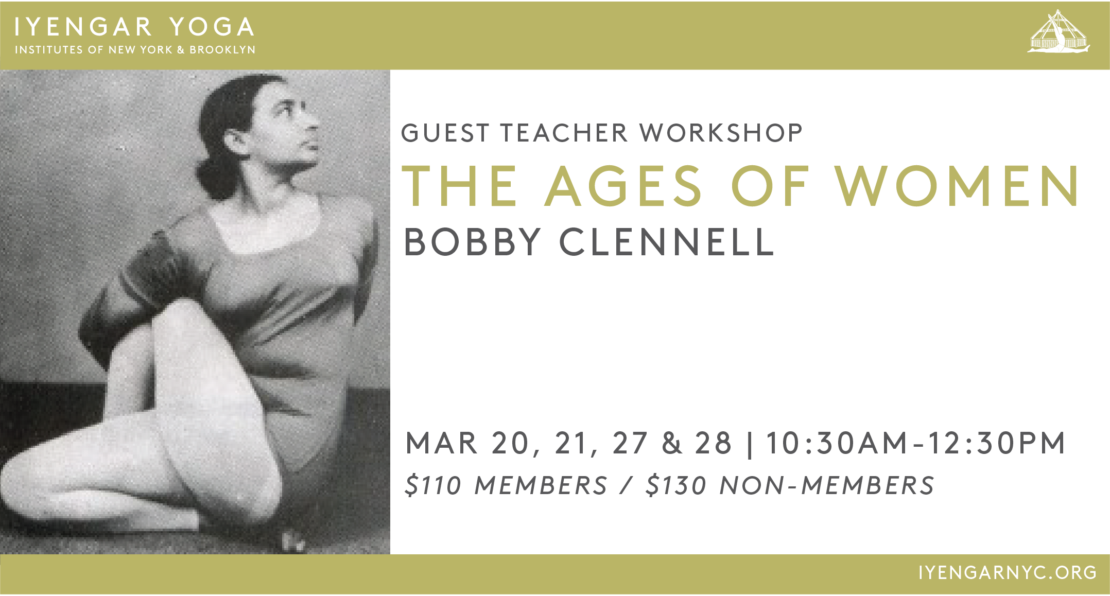Guest Teacher Workshop Taught By Bobby Clennell

- Part 1: Childhood to Adolescence – March 20
- Part 2: Menstruation, Pregnancy & Postpartum – March 21
- Part 3: Perimenopause & Menopause – March 27
- Part 4: Post Menopause – March 28
All Sessions will be recorded. Students will have access for fourteen (14) days following each session.
REGISTER
$110 MEMBERS / $130 NON-MEMBERS
Using a wide range of yoga poses, Bobby Clennell will take us through the various phases of a woman’s life and show how to adapt our yoga practice according to our age.
Come prepared to be 5 years old! Can you remember yourself as a teenager? Even if you have never been pregnant, experience it in this workshop via yogasana. Postpartum? Practice as if you had just given birth. Are you under the impression that menopause will never happen? Get a taste of a menopause and post menopause practice with some carefully selected poses. Practice being elderly – it’s not so bad! – with some of the poses Bobby used to watch BKS Iyengar doing in his later years.
Men are welcome! Come find your inner woman.
Part 1: Childhood to Adolescence (Ages 4 to 16)
4/5 – 11 years: Children.
Yoga provides a firm foundation for a child’s physical development. It also trains them to evolve their intelligence and improve concentration.
A teacher should know that a child, whose mind is always in the present, dislikes monotony. They want to try everything that is new. Similarly, children don’t need precision. For adults, precision is important, because if something goes wrong, they get injured. Children fall so many times, but they don’t hurt themselves.
Although the teacher needs to be careful, there is no need to be serious! Youngsters may be imprecise, but they do yoga without fear or doubt, so do not bore them with corrections. Keep it moving! Be like a child when you teach them, but at the same time learn how to draw their attention.
11 – 16 years: Adolescence
At adolescence, a young girl undergoes many sudden changes in body and mind and she has to build-herself up to face these upheavals. A practice can be tailored to concentrate on poses that increase her confidence and will-power, strengthen her emotional stability, regulate mood swings, and avoid menstrual disorders.
Know, as a teacher, that because at this stage of her life her bones are getting firmer she can hold the poses longer and you can move toward teaching with more intensity (than you would for young children) and help her develop muscular strength.
Part 2: Menstruation, Pregnancy & Postpartum (Ages 15 to 45)
Bobby will show how to maintain a cyclically responsive practice that attunes you to your innermost reality, brings about individual health, and draws you back to nature’s rhythms. By navigating the entire month’s hormonal fluctuations with specific asanas, you will promote vibrant good health and maintain emotional stability.
A Menstrual Practice: Learn how to stick to a practice that keeps you healthy, does not disturb the menstrual flow and ensures you get the rest you need.
Fertility: We will explore the practices that optimize reproductive health and improve the chances of conceiving.
During pregnancy, yoga can be tailored to suit the body’s changing needs and capabilities. As well as strengthening the spine, it also helps the body deal with many of the problems common to pregnancy: poor circulation, fluctuations in blood pressure, excess weight gain, fatigue, edema, and urinary problems. A regular yoga practice during pregnancy also strengthens and prepares the body for the demands of labor, eases delivery, and helps restore energy levels after the baby is born.
Postpartum: After delivery, the practice of pranayama stabilizes emotions and helps to ensure a plentiful supply of milk. During this period of recovery, the emphasis should be on recuperative poses, gradually building up to more active ones. At around nine months to a year after delivery, normal practice can be resumed.
Part 3: Perimenopause & Menopause (Ages 45 – 52)
Just as physical and psychological changes occur when menstruation begins, you can expect to face disturbances again as it comes to an end.
Peri-menopause are the years that lead up to the near shut down of ovarian function. From the mid 40’s a woman may begin to experience clear symptoms of estrogen reduction, such as irregular periods (shorter or longer, lighter or heavier), or headaches that are showing up for the first time. The benefits of yoga during this time are substantial and a regular practice helps to maintain physical, mental and emotional health. We will learn to navigate through this transition with practices that calm the nerves, keeps weight under control, maintains a healthy digestive system and supports the functioning of the endocrine system.
Part 4: Post Menopause (Ages 52 – 75)
There is a similarity between the post-menopausal phase and adolescence. We remember ourselves at 12 and 13 years of age, facing a different future.
It is true that some of the issues experienced during peri-menopause can include stiffness, weakness and loss of confidence. This can, however, be the strongest phase of a woman’s life. She is no longer subject to the continual ebb and flow of monthly hormonal activity. With her yoga practice, she negotiates the landscape between rebuilding strength and her new-found ability to focus properly with an acceptance that she is aging. Yoga now becomes extremely interesting! At this stage of a woman’s life, there is a constructive struggle and the body gets more expressive. When we learn how to get the sharpness back into our practice, we can experience a whole new lease of life.
Age 75 – on. The transition into old age brings with it many challenges, such as increased physical fragility, low metabolism, absent mindedness, and a general lack of coordination. At this stage props are a great help, enabling beneficial poses to be achieved with less effort, which in turn helps to maintain blood circulation and a healthy nervous system. The aim of yoga is to maintain both physical and mental health, therefore bringing about balance and harmony. In old age this is achieved by adapting the practice and adopting new methods with which to achieve physical poise and stability and lightness of spirit and mood. It is not unusual at this stage of a practitioners life to become more interested in yoga in its broadest sense – the spiritual experience- and one’s place in the grander scheme of things.
